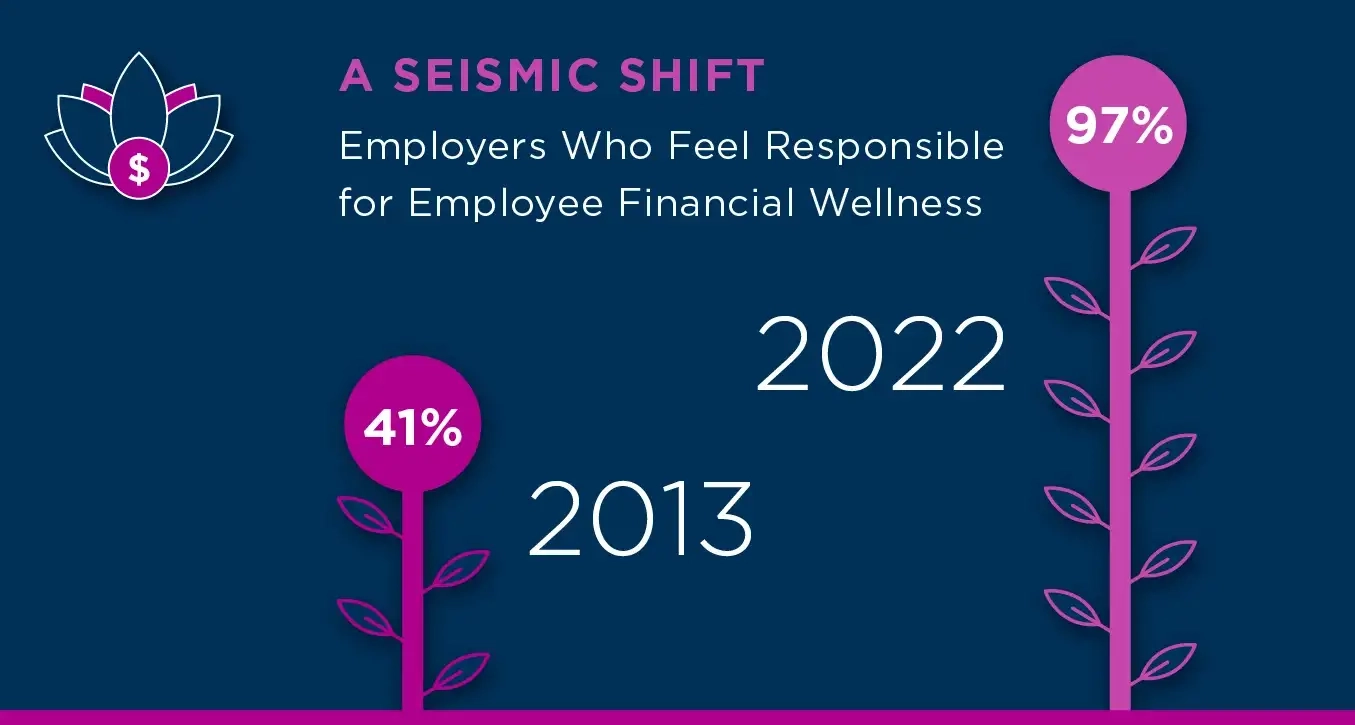97 percent of employers now feel responsible for employee financial wellness according to Bank of America’s 2022 Navigating a New Era of Financial Wellness report, up from 41 percent a decade ago.

A seismic shift is afoot among business and human resource leaders who now feel more responsible for their employees financial wellness than in decades past.
A decade ago 41 percent of employers felt responsible for employee financial wellness. Today, that number has more than doubled to 97 percent according to Bank of America’s 2022 Navigating a New Era of Financial Wellness report.
Part of this staggering shift is demand driven. 82 percent of employees now expect their employers to play a role in supporting their financial wellness.
Millennials and Gen Z workers, especially, expect employers to offer benefits and financial wellness support that previous generations didn’t even imagine, because they face financial challenges that their parents and grandparents did not.
Millennial workers, now twenty- to forty-somethings, are worse off financially than their parents’ generation, for the first time in U.S history and only one in ten or so Gen Z workers coming up behind them rate their financial wellness as high according to a recent TIAA survey.
Decades-high inflation and broader changes in our system of jobs and benefits have eroded the financial health of the U.S. workforce to the point where the majority of workers have little shot at financial security. This reality is bad for businesses and for employees.
Financial stress hampers worker productivity, adds to mental health challenges, and leads to higher rates of turnover, effects that business leaders increasingly understand–which brings us to the supply-side cause of this cosmic shift in feelings of responsibility among employers for their employees’ financial health.
This growing awareness among business leaders of the business case for offering robust financial wellness benefits is good news for workers and for businesses.
Business leaders now know the reality is that workers are stressed about money. It used to be that this stress largely fell on the shoulders of lower- and moderate-income workers. No longer. 63 percent of U.S. workers now live paycheck to paycheck including nearly half of employees earning at least $100,000 per year.
They know that most financially-stressed employees are distracted by their finances at work, spending at least three hours per week on personal finance issues during work time, and that “employers who direct their employees to financial wellness resources to help alleviate stress have the potential to reap tangible gains in employee focus and productivity,” according to Morgan Stanley.
And, they increasingly know the connections among employee financial health benefits, satisfaction, retention, and productivity. As Bank of America’s report informs us: ninety-one percent of employers see higher employee satisfaction when they offer tools and resources to help employees manage their financial well-being.
So, what kinds of tools and resources are best positioned to make a real difference for businesses in the years ahead? Personal Finance Coaching. While the vast majority of businesses now offer some form of financial wellness benefit (most often retirement focused, think 401K, insurance), only one in four (24 percent) HR professionals say their employer offers financial coaching to all employees, and the majority of the coaching that is offered is not personal to the individual. Personal Finance Coaching remains a largely untapped resource for businesses nationwide.
Given the seismic shift afoot, now is the time for employers that are looking to maximize the benefits of a financially healthy workforce in 2023 to take that step to tap it.






